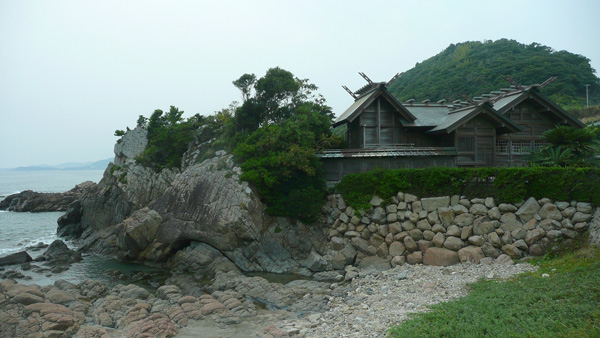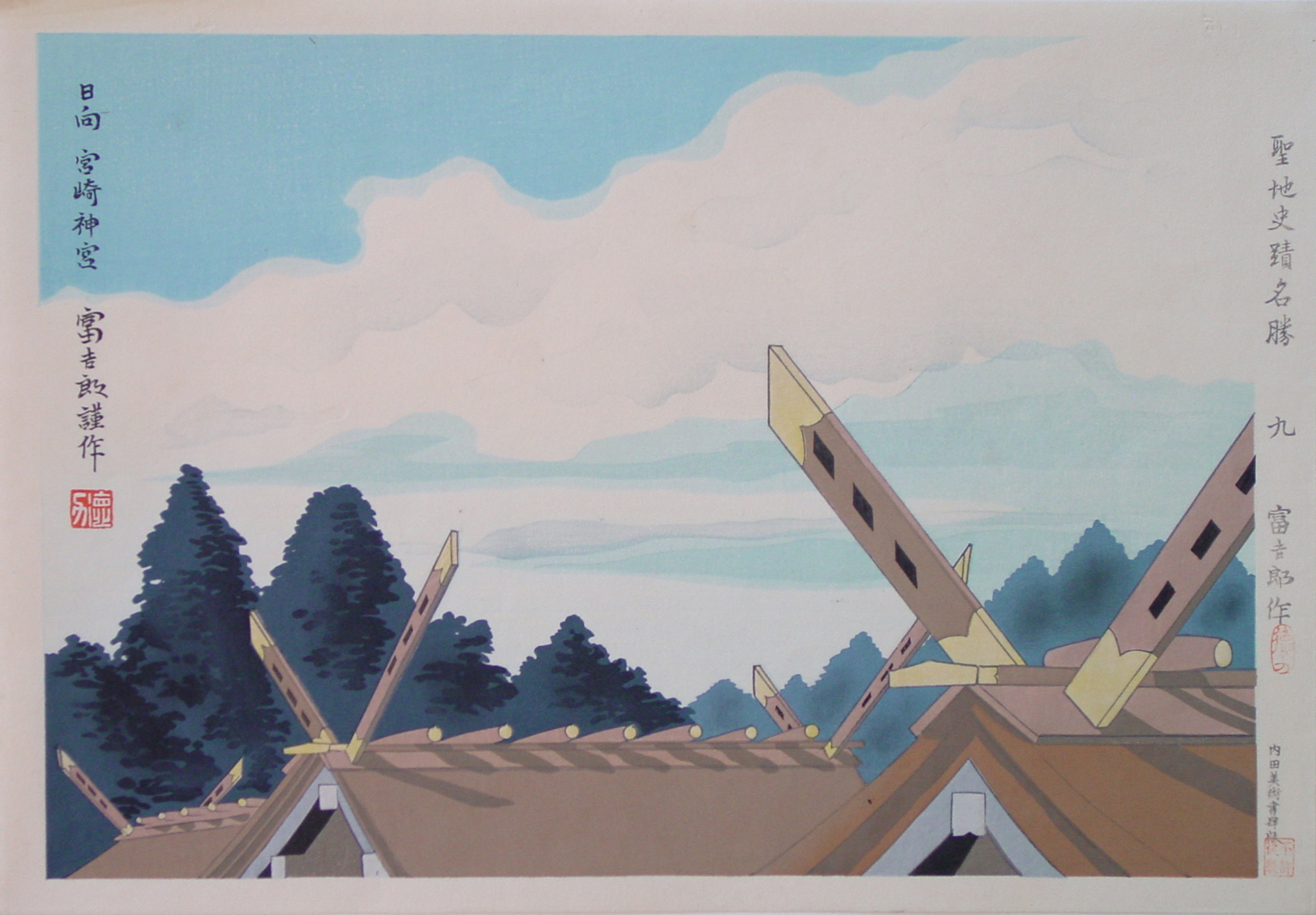About This Print
Print number nine of the fifty prints series Scenes of Sacred and Historic Places (Seichi Shiseki Meisho) published by Uchida Woodblock Printing Company in 1941. This is an untypical composition for Tokuriki, focusing on the roofs and protruding cross-beams of these cedar-constructed buildings on the grounds of Ohmi Shrine near Miyazaki.The Series - Scenes of Sacred and Historic Places
The print artist Tokuriki and the publisher Unsōdō created two series of prints to mark Kigen 2600, or the 2600th year of Japan's mythical founding as a nation. The first, a paean to Mount Fuji, a sacred site of pilgrimage and worship, titled Thirty-Six Views of Mount Fuji, harkened back to Hokusai’s famous 1831 series of the same name. The second series, Scenes of Sacred and Historic Places, capitalized on the nationalist ideology that Japan was a divine land, presenting overtly nationalistic landscapes including shrines, temples, castles, places associated with the divine origins of Japan, Meiji era history and samurai
culture.
In his commentary on this series, the artist wrote that his devotion to these sites is intended to demonstrate to the people the dignity of the national polity, going on to say that he advocates prints as a means of providing comfort and pleasure to the wholesome citizens of the nation.
This series was extremely popular with domestic and foreign buyers who purchased one thousand copies within a short time after issuance.1 I imagine that foreign buyers were enchanted by the lovely scenes with much of the import of each print escaping them. In the 1950s, six prints from this series were re-printed under the title The Album of Famous Views of Japan and eight additional prints were re-printed under the title The Eight Views of Japan. Later printings omit the information in the margin and some position the artist's signature and print title within the image in a different location from the original issue.
For images of all the prints in the series, go to the website of Ross Walker's Ohmi Gallery at http://www.ohmigallery.com/Gallery/Tokuriki/SacredPlaces.htm.
1 Modern Japanese Woodblock Prints - The Early Years, Helen Merritt, University of Hawaii Press, 1998, p. 89.
In his commentary on this series, the artist wrote that his devotion to these sites is intended to demonstrate to the people the dignity of the national polity, going on to say that he advocates prints as a means of providing comfort and pleasure to the wholesome citizens of the nation.
For images of all the prints in the series, go to the website of Ross Walker's Ohmi Gallery at http://www.ohmigallery.com/Gallery/Tokuriki/SacredPlaces.htm.
1 Modern Japanese Woodblock Prints - The Early Years, Helen Merritt, University of Hawaii Press, 1998, p. 89.
Margin Annotations of Original Edition (top to bottom) and Print Title Within Image
 series title Seichi Shiseki Meishō 聖地 史蹟 名勝 |  九 (9) |  Tomikichiro Saku 富吉郎 作 (Made by Tomikichiro) followed by oval seal1 |  内田美術書肆版 (Uchida Fine Art Shop) followed in seal form by Fukyo Fukusei (Reproduction forbidden) | Print Title |
1 possibly a reproduction of an old censor's seal
The title of each print appears within the image area along with the artist's signature and seal. The artist's signature is comprised of the artist's name 富吉郎 (Tomikichirō) either by itself, or followed by the single kanji character 作 (saku "made by") or by 謹 (kin "respectfully") followed by the character 作, as shown below.

Ohmi Miyazaki Shrine

History of Ohmi Shrine
Source: website of the Oomi Jinja http://www.oomijinja.jp/history/index2.htm
The main diety of Omijinja is the Great Sun Goddess, Amaterasu omikami, the most famous of all the gods and goddesses in the Japanese pantheon. The current structure was built in 1936. It is uncertain when the original building was built because its history is shrouded in myth. An old document of the shrine, the "Shinmeiki", says that when the god Niniginomikoto was sent from heaven to Takachiho, the mythical place of the descent of the Japanese gods, by Sumeomikami, he spotted a beautiful cove and was so impressed that he enshrined the Great Sun Goddess there and prayed for peace. Later Sumeomikami was also enshrined as the guardian of the village.
Legend also has it that when Jimmu, the first mythical emperor sailed to conquer eastern Japan, on his way he stopped at the shrine to pray for victory and safe passage. While he was there he left his whale hunting spear as an offering.
Since then the shrine had been patronized by successive lords of Hichiya and Nobeoka castles and other local governors. Omijinja has also been called, "Oisesama" because it resembles the architectural design of Ise shrine, the largest and most influential shrine in Japan.
Architecture of Ohmi Shrine
Source: website of Institute for Japanese Culture and Classics, Kokugakuin University http://www2.kokugakuin.ac.jp/ijcc/wp/bts/bts_c.html
The crossed beams extending upwards from both ends of the roof gables in Shintō architecture are called Chigi 千木. The short log-shaped sections set horizontally on the roof at right angles to the ridge are called Katsuogi 堅魚木. Both date to ancient times.
Print Details
| IHL Catalog | #437 |
| Title | Miyazaki Shrine in Hyuga province 日向 宮崎神宮 Hiyuga Miyazaki Jinjya |
| Series | Scenes of Sacred and Historic Places (also seen translated as "Collected Prints of Sacred, Historic and Scenic Places") 聖地 史蹟 名勝 Seichi Shiseki Meisho |
| Artist | Tokuriki Tomikichirō (1902-2000) |
| Signature | Tomikichirō kin saku (富吉郎 謹作) |
| Seal |  |
| Date | September 1941 |
| Edition | original (first) edition |
| Publisher | Uchida Bijutsu Shoten |
| Impression | excellent |
| Colors | excellent |
| Condition | excellent - minor residue top corners verso from previous folio mounting |
| Genre | shin hanga (new print) |
| Miscellaneous | 九 #9 in series |
| Format | horizontal oban |
| H x W Paper | 11 1/4 x 16 1/4 in. (28.6 x 41.3 cm) |
| H x W Image | 10 3/8 x 15 (26.4 x 38.1 cm) |
| Collections This Print | Penn Libraries, Rare Book & Manuscript Library - Rare Book Collection Call no.: Portfolio NE1325.T65 A4 1940 |
| Reference Literature | |


